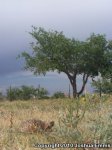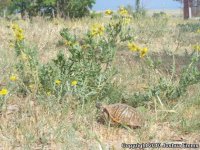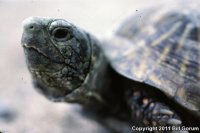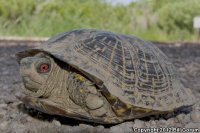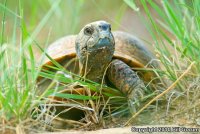| Range: |
 The two subspecies integrade, so the line is not a solid division. Close to where the subspecies come together, animals may show traits of one, or both subspecies. The two subspecies integrade, so the line is not a solid division. Close to where the subspecies come together, animals may show traits of one, or both subspecies. |
| Other Names: |
Box Tortoise, Western Box Turtle |
| Subspecies: |
Desert Box Turtle Terrapene ornata luteola: Pale radiating lines on shell more numerous than in Ornate Box Turtle, 11-14 on 2nd costal sheild. Markings become less distinct with advancing age and eventually are lost; shells of most old individuals are uniform straw color or pale greenish brown.
Ornate Box Turtle Terrapene ornata ornata: Fewer pale radiating lines (5-10) on 2nd costal sheild than in Desert Box Turtle. Usually no obvious fading of shell with advancing age.
|
| Description: |
These land-dwelling turtles (not tortoises) have a high-domed carapace, not serrated posteriorly. Four toes on rear feet. Transverse hinge across plastron. Upper jaw with downturned "beak" without notch. Carapace dark brown or reddish brown often with yellow middorsal stripe. Conspicuous pattern of radiating yellow stripes on scutes, with dark seams. Plastron dark brown or tan; plastron with pattern of radiating lines. Skin brown with spots of yellow on limbs and head. Tail can have yellow stripe. Head can be greenish. Adult males with red iris; females with yellow-brown iris. The carapace length of an adult Terrapene ornata typically measures between 10-13 cm (4-5 in). |
| Similar Species: |
No other New Mexico Turtle has a plastron with only a single hinge. |
| Habitat: |
This box turtle species is generally restricted to the prairies devoid of trees and dominated by grass and low shrubs. |
| Behavior: |
A diurnal species, the ornate box turtle spends its day alternating between basking, feeding, and seeking shelter from the heat of the day. Shelter may be burrows in sandy soils or under fallen vegetation. Activity is often increased following summer rains and thunderstorms. |
| Hibernation: |
Underground during the cool months. |
| Reproduction: |
Nesting occurs in the late spring and summer. Clutch sizes range from 2-8 and two clutches may be laid each year. Incubation averages around 80 days. |
| Diet: |
These turtles are ominvorous, usually showing a preference toward animal foods. However at times certain plant foods may be eaten solely and mulberry is a favorite. Feeding tends to be opportunistic; this may explain why an abundant food, such as insects, is an important staple in their diet. The list of foods eaten is long and includes such diverse items as dead mammals, birds and eggs, reptiles (including dead box turtles), spadefoot toad tadpoles (but not adults), crayfish, pillbugs, earthworms, carrion, spiderwort, cactus fruits and stems, melons and invertebrates found in cow dung, along with some of the dung itself.
Food items are grasped by the jaws and swallowed whole or torn apart with help from the front claws, All feeding activity occurs during the daytime, using sight to locate and smell to identify food items. |



